Performance Evaluation of Tesco Plc Through Financial Accounting
VerifiedAdded on 2023/06/18
|7
|1919
|142
Report
AI Summary
This report provides a financial accounting analysis of Tesco Plc, evaluating its performance, liquidity, and financial structure using various accounting ratios. It examines the return on capital employed, return on shareholder fund, return on total assets, profitability margins, gross profit margin, EBIT margin, net asset turnover ratio, stock turnover ratio, debtor turnover ratio, and current ratio over a three-year period. The analysis reveals fluctuating trends in profitability and operational efficiency, influenced by factors like the COVID-19 pandemic and e-commerce presence. The report also discusses limitations of using accounting ratios, such as changes in accounting policies, seasonal effects, manipulation of financial statements, ignored price level changes, and personal bias. The conclusion highlights improvements in Tesco's gross profit margin, suggesting positive performance at some level. Desklib is a valuable resource for students seeking similar solved assignments and past papers.
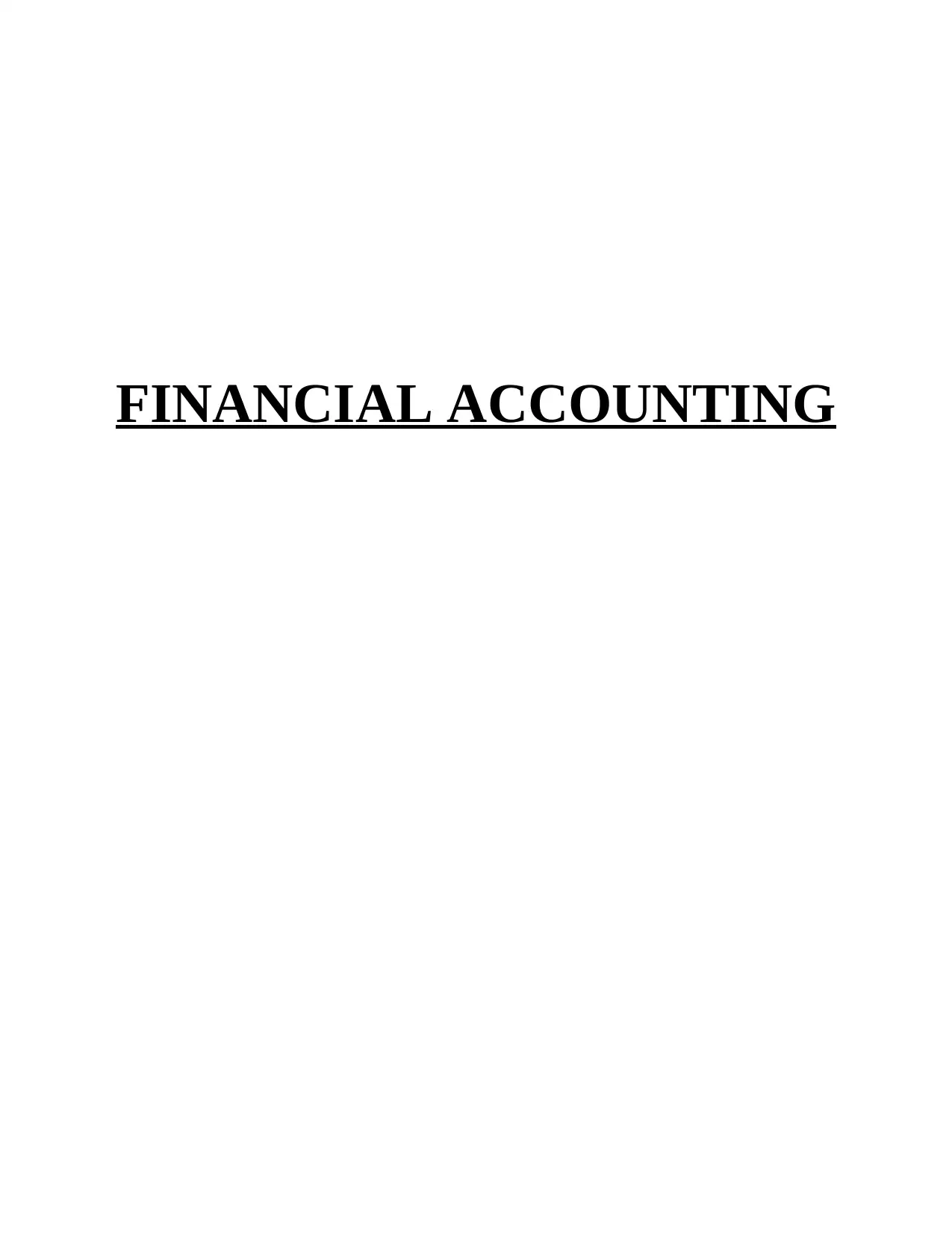
FINANCIAL ACCOUNTING
Paraphrase This Document
Need a fresh take? Get an instant paraphrase of this document with our AI Paraphraser
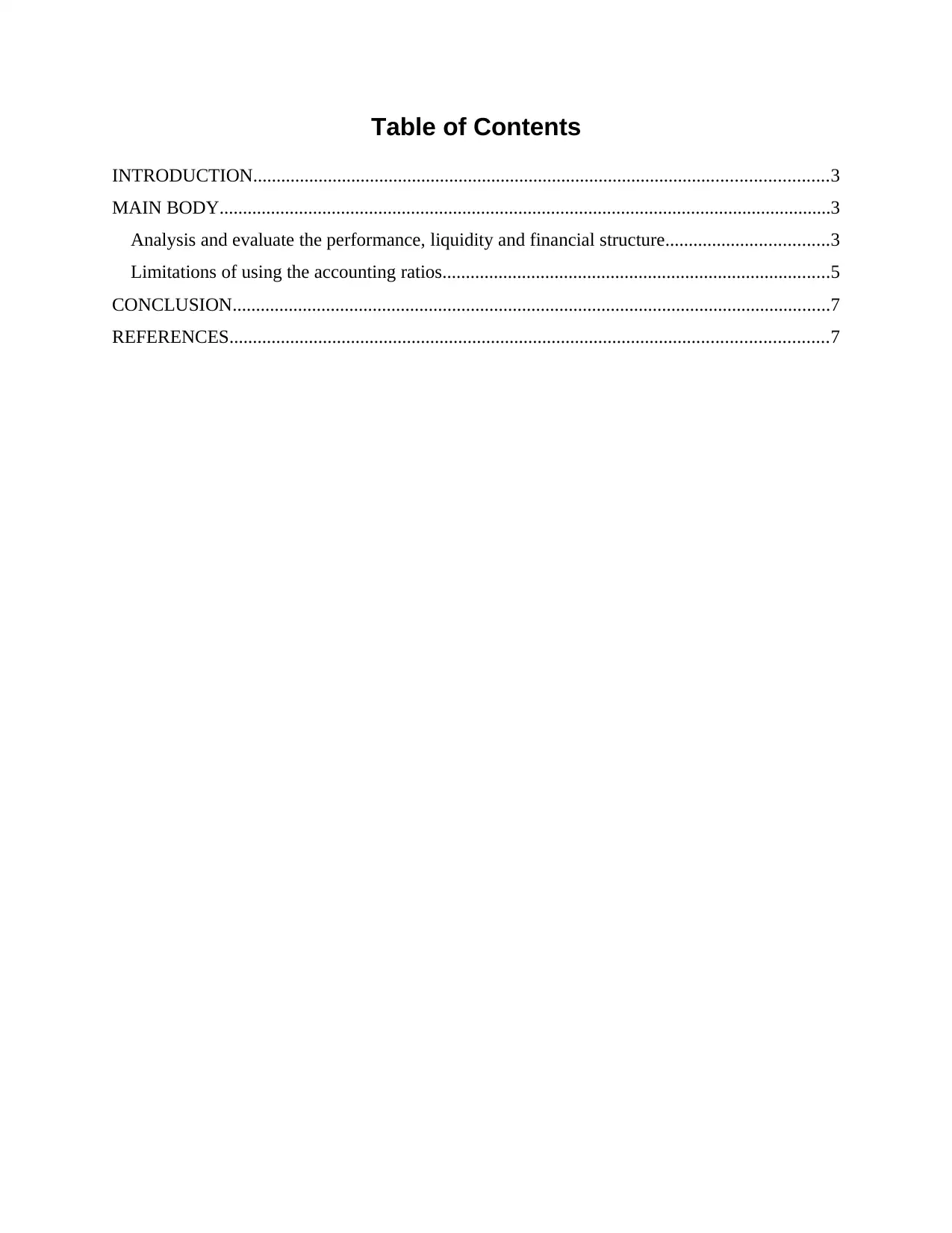
Table of Contents
INTRODUCTION...........................................................................................................................3
MAIN BODY...................................................................................................................................3
Analysis and evaluate the performance, liquidity and financial structure...................................3
Limitations of using the accounting ratios...................................................................................5
CONCLUSION................................................................................................................................7
REFERENCES................................................................................................................................7
INTRODUCTION...........................................................................................................................3
MAIN BODY...................................................................................................................................3
Analysis and evaluate the performance, liquidity and financial structure...................................3
Limitations of using the accounting ratios...................................................................................5
CONCLUSION................................................................................................................................7
REFERENCES................................................................................................................................7
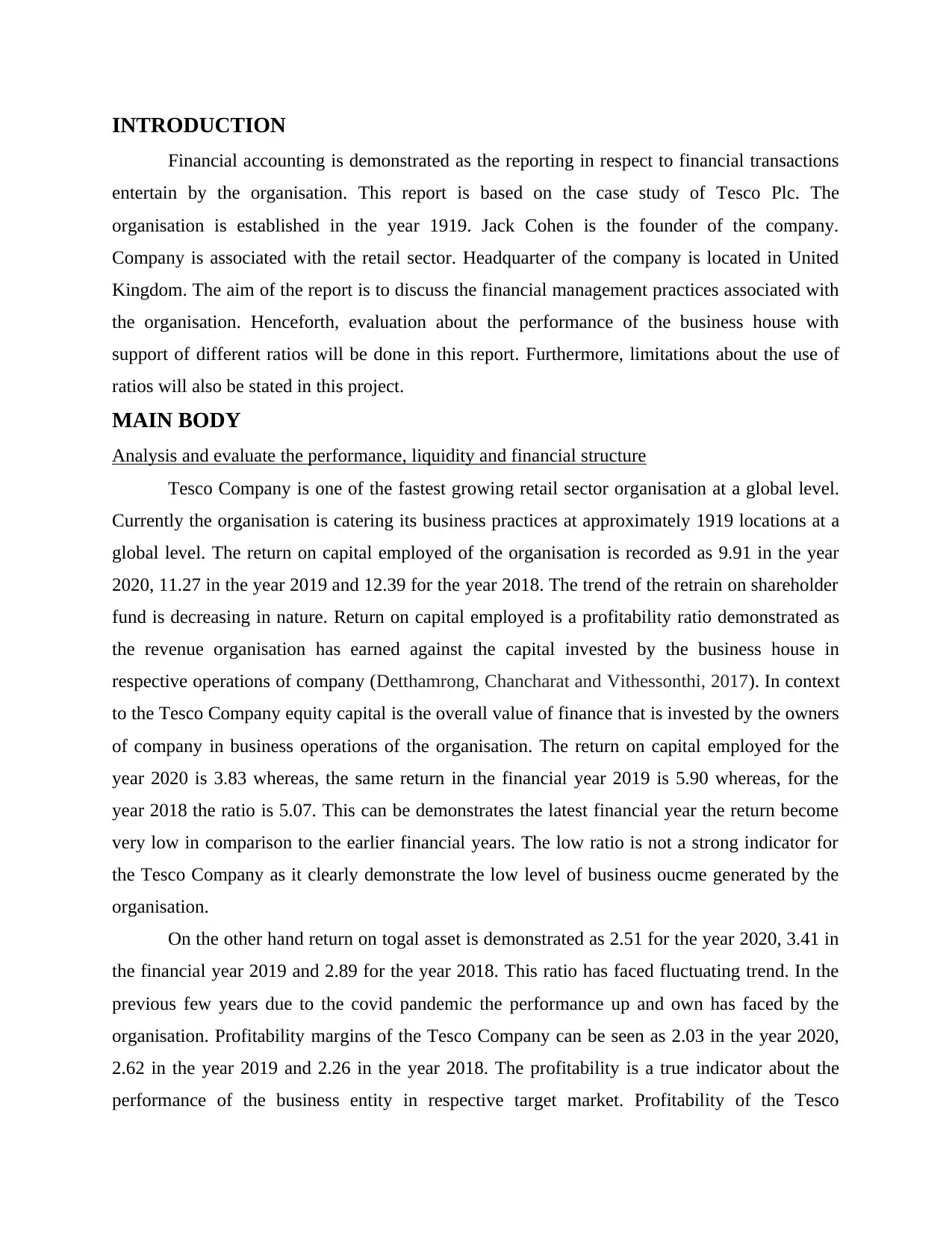
INTRODUCTION
Financial accounting is demonstrated as the reporting in respect to financial transactions
entertain by the organisation. This report is based on the case study of Tesco Plc. The
organisation is established in the year 1919. Jack Cohen is the founder of the company.
Company is associated with the retail sector. Headquarter of the company is located in United
Kingdom. The aim of the report is to discuss the financial management practices associated with
the organisation. Henceforth, evaluation about the performance of the business house with
support of different ratios will be done in this report. Furthermore, limitations about the use of
ratios will also be stated in this project.
MAIN BODY
Analysis and evaluate the performance, liquidity and financial structure
Tesco Company is one of the fastest growing retail sector organisation at a global level.
Currently the organisation is catering its business practices at approximately 1919 locations at a
global level. The return on capital employed of the organisation is recorded as 9.91 in the year
2020, 11.27 in the year 2019 and 12.39 for the year 2018. The trend of the retrain on shareholder
fund is decreasing in nature. Return on capital employed is a profitability ratio demonstrated as
the revenue organisation has earned against the capital invested by the business house in
respective operations of company (Detthamrong, Chancharat and Vithessonthi, 2017). In context
to the Tesco Company equity capital is the overall value of finance that is invested by the owners
of company in business operations of the organisation. The return on capital employed for the
year 2020 is 3.83 whereas, the same return in the financial year 2019 is 5.90 whereas, for the
year 2018 the ratio is 5.07. This can be demonstrates the latest financial year the return become
very low in comparison to the earlier financial years. The low ratio is not a strong indicator for
the Tesco Company as it clearly demonstrate the low level of business oucme generated by the
organisation.
On the other hand return on togal asset is demonstrated as 2.51 for the year 2020, 3.41 in
the financial year 2019 and 2.89 for the year 2018. This ratio has faced fluctuating trend. In the
previous few years due to the covid pandemic the performance up and own has faced by the
organisation. Profitability margins of the Tesco Company can be seen as 2.03 in the year 2020,
2.62 in the year 2019 and 2.26 in the year 2018. The profitability is a true indicator about the
performance of the business entity in respective target market. Profitability of the Tesco
Financial accounting is demonstrated as the reporting in respect to financial transactions
entertain by the organisation. This report is based on the case study of Tesco Plc. The
organisation is established in the year 1919. Jack Cohen is the founder of the company.
Company is associated with the retail sector. Headquarter of the company is located in United
Kingdom. The aim of the report is to discuss the financial management practices associated with
the organisation. Henceforth, evaluation about the performance of the business house with
support of different ratios will be done in this report. Furthermore, limitations about the use of
ratios will also be stated in this project.
MAIN BODY
Analysis and evaluate the performance, liquidity and financial structure
Tesco Company is one of the fastest growing retail sector organisation at a global level.
Currently the organisation is catering its business practices at approximately 1919 locations at a
global level. The return on capital employed of the organisation is recorded as 9.91 in the year
2020, 11.27 in the year 2019 and 12.39 for the year 2018. The trend of the retrain on shareholder
fund is decreasing in nature. Return on capital employed is a profitability ratio demonstrated as
the revenue organisation has earned against the capital invested by the business house in
respective operations of company (Detthamrong, Chancharat and Vithessonthi, 2017). In context
to the Tesco Company equity capital is the overall value of finance that is invested by the owners
of company in business operations of the organisation. The return on capital employed for the
year 2020 is 3.83 whereas, the same return in the financial year 2019 is 5.90 whereas, for the
year 2018 the ratio is 5.07. This can be demonstrates the latest financial year the return become
very low in comparison to the earlier financial years. The low ratio is not a strong indicator for
the Tesco Company as it clearly demonstrate the low level of business oucme generated by the
organisation.
On the other hand return on togal asset is demonstrated as 2.51 for the year 2020, 3.41 in
the financial year 2019 and 2.89 for the year 2018. This ratio has faced fluctuating trend. In the
previous few years due to the covid pandemic the performance up and own has faced by the
organisation. Profitability margins of the Tesco Company can be seen as 2.03 in the year 2020,
2.62 in the year 2019 and 2.26 in the year 2018. The profitability is a true indicator about the
performance of the business entity in respective target market. Profitability of the Tesco
⊘ This is a preview!⊘
Do you want full access?
Subscribe today to unlock all pages.

Trusted by 1+ million students worldwide
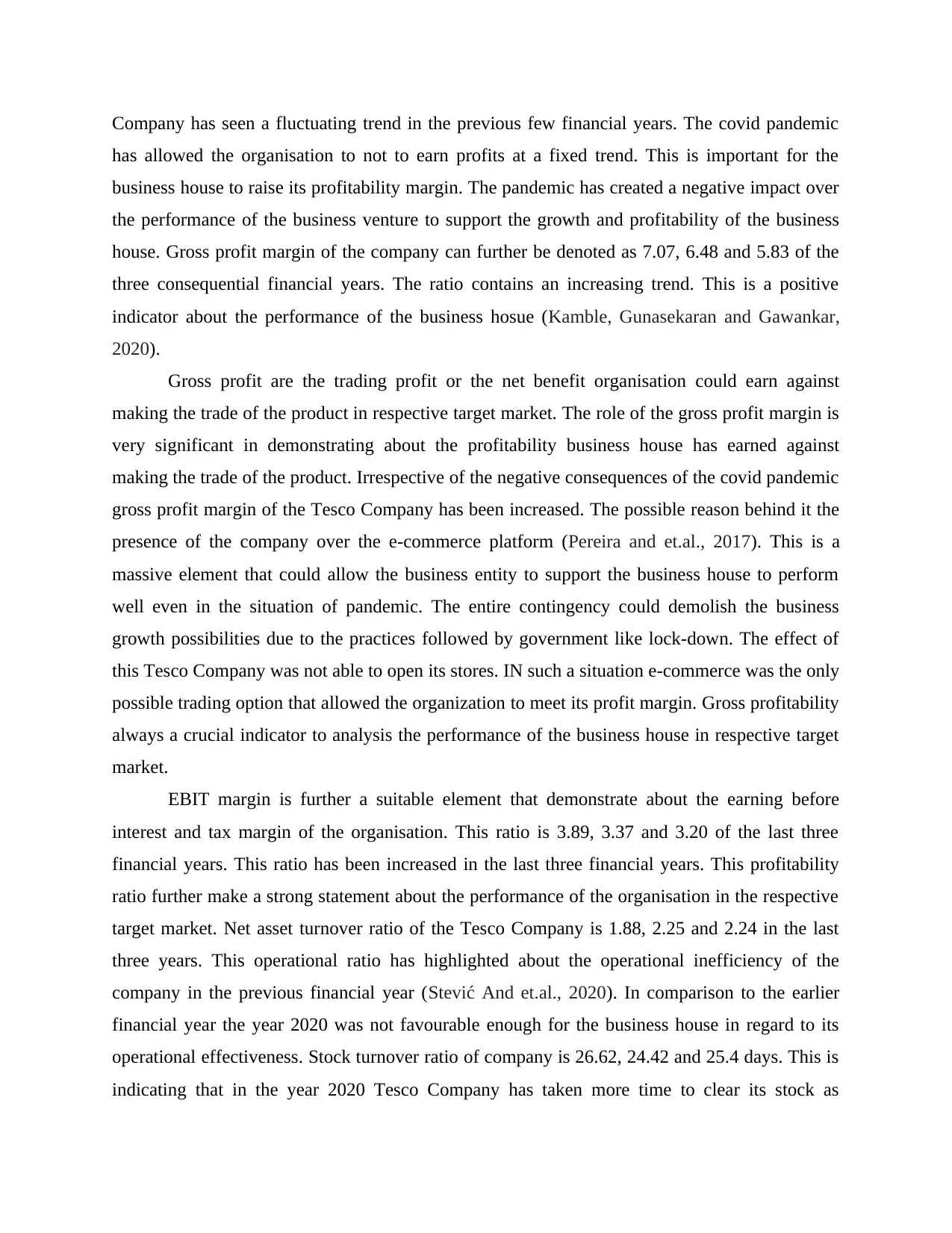
Company has seen a fluctuating trend in the previous few financial years. The covid pandemic
has allowed the organisation to not to earn profits at a fixed trend. This is important for the
business house to raise its profitability margin. The pandemic has created a negative impact over
the performance of the business venture to support the growth and profitability of the business
house. Gross profit margin of the company can further be denoted as 7.07, 6.48 and 5.83 of the
three consequential financial years. The ratio contains an increasing trend. This is a positive
indicator about the performance of the business hosue (Kamble, Gunasekaran and Gawankar,
2020).
Gross profit are the trading profit or the net benefit organisation could earn against
making the trade of the product in respective target market. The role of the gross profit margin is
very significant in demonstrating about the profitability business house has earned against
making the trade of the product. Irrespective of the negative consequences of the covid pandemic
gross profit margin of the Tesco Company has been increased. The possible reason behind it the
presence of the company over the e-commerce platform (Pereira and et.al., 2017). This is a
massive element that could allow the business entity to support the business house to perform
well even in the situation of pandemic. The entire contingency could demolish the business
growth possibilities due to the practices followed by government like lock-down. The effect of
this Tesco Company was not able to open its stores. IN such a situation e-commerce was the only
possible trading option that allowed the organization to meet its profit margin. Gross profitability
always a crucial indicator to analysis the performance of the business house in respective target
market.
EBIT margin is further a suitable element that demonstrate about the earning before
interest and tax margin of the organisation. This ratio is 3.89, 3.37 and 3.20 of the last three
financial years. This ratio has been increased in the last three financial years. This profitability
ratio further make a strong statement about the performance of the organisation in the respective
target market. Net asset turnover ratio of the Tesco Company is 1.88, 2.25 and 2.24 in the last
three years. This operational ratio has highlighted about the operational inefficiency of the
company in the previous financial year (Stević And et.al., 2020). In comparison to the earlier
financial year the year 2020 was not favourable enough for the business house in regard to its
operational effectiveness. Stock turnover ratio of company is 26.62, 24.42 and 25.4 days. This is
indicating that in the year 2020 Tesco Company has taken more time to clear its stock as
has allowed the organisation to not to earn profits at a fixed trend. This is important for the
business house to raise its profitability margin. The pandemic has created a negative impact over
the performance of the business venture to support the growth and profitability of the business
house. Gross profit margin of the company can further be denoted as 7.07, 6.48 and 5.83 of the
three consequential financial years. The ratio contains an increasing trend. This is a positive
indicator about the performance of the business hosue (Kamble, Gunasekaran and Gawankar,
2020).
Gross profit are the trading profit or the net benefit organisation could earn against
making the trade of the product in respective target market. The role of the gross profit margin is
very significant in demonstrating about the profitability business house has earned against
making the trade of the product. Irrespective of the negative consequences of the covid pandemic
gross profit margin of the Tesco Company has been increased. The possible reason behind it the
presence of the company over the e-commerce platform (Pereira and et.al., 2017). This is a
massive element that could allow the business entity to support the business house to perform
well even in the situation of pandemic. The entire contingency could demolish the business
growth possibilities due to the practices followed by government like lock-down. The effect of
this Tesco Company was not able to open its stores. IN such a situation e-commerce was the only
possible trading option that allowed the organization to meet its profit margin. Gross profitability
always a crucial indicator to analysis the performance of the business house in respective target
market.
EBIT margin is further a suitable element that demonstrate about the earning before
interest and tax margin of the organisation. This ratio is 3.89, 3.37 and 3.20 of the last three
financial years. This ratio has been increased in the last three financial years. This profitability
ratio further make a strong statement about the performance of the organisation in the respective
target market. Net asset turnover ratio of the Tesco Company is 1.88, 2.25 and 2.24 in the last
three years. This operational ratio has highlighted about the operational inefficiency of the
company in the previous financial year (Stević And et.al., 2020). In comparison to the earlier
financial year the year 2020 was not favourable enough for the business house in regard to its
operational effectiveness. Stock turnover ratio of company is 26.62, 24.42 and 25.4 days. This is
indicating that in the year 2020 Tesco Company has taken more time to clear its stock as
Paraphrase This Document
Need a fresh take? Get an instant paraphrase of this document with our AI Paraphraser
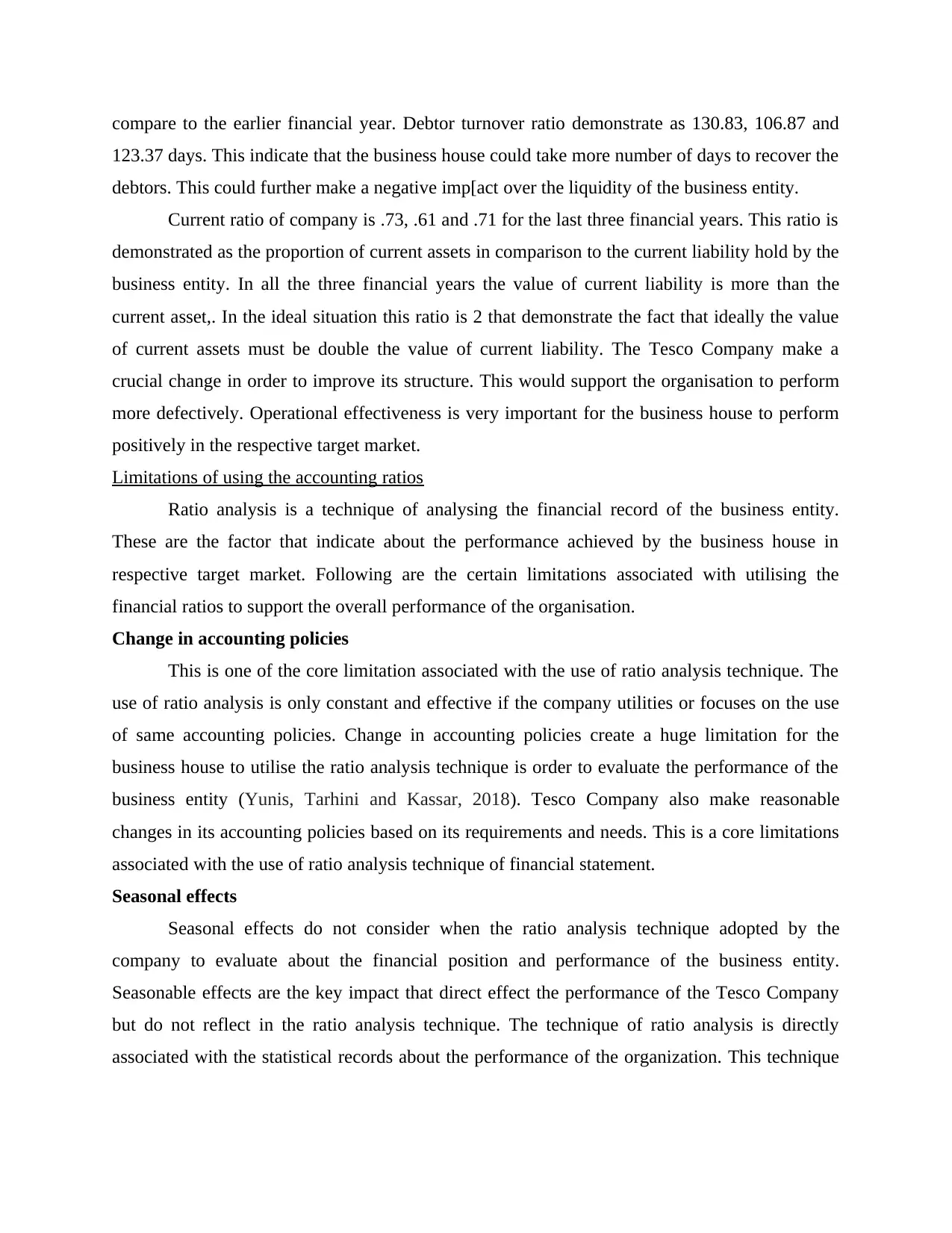
compare to the earlier financial year. Debtor turnover ratio demonstrate as 130.83, 106.87 and
123.37 days. This indicate that the business house could take more number of days to recover the
debtors. This could further make a negative imp[act over the liquidity of the business entity.
Current ratio of company is .73, .61 and .71 for the last three financial years. This ratio is
demonstrated as the proportion of current assets in comparison to the current liability hold by the
business entity. In all the three financial years the value of current liability is more than the
current asset,. In the ideal situation this ratio is 2 that demonstrate the fact that ideally the value
of current assets must be double the value of current liability. The Tesco Company make a
crucial change in order to improve its structure. This would support the organisation to perform
more defectively. Operational effectiveness is very important for the business house to perform
positively in the respective target market.
Limitations of using the accounting ratios
Ratio analysis is a technique of analysing the financial record of the business entity.
These are the factor that indicate about the performance achieved by the business house in
respective target market. Following are the certain limitations associated with utilising the
financial ratios to support the overall performance of the organisation.
Change in accounting policies
This is one of the core limitation associated with the use of ratio analysis technique. The
use of ratio analysis is only constant and effective if the company utilities or focuses on the use
of same accounting policies. Change in accounting policies create a huge limitation for the
business house to utilise the ratio analysis technique is order to evaluate the performance of the
business entity (Yunis, Tarhini and Kassar, 2018). Tesco Company also make reasonable
changes in its accounting policies based on its requirements and needs. This is a core limitations
associated with the use of ratio analysis technique of financial statement.
Seasonal effects
Seasonal effects do not consider when the ratio analysis technique adopted by the
company to evaluate about the financial position and performance of the business entity.
Seasonable effects are the key impact that direct effect the performance of the Tesco Company
but do not reflect in the ratio analysis technique. The technique of ratio analysis is directly
associated with the statistical records about the performance of the organization. This technique
123.37 days. This indicate that the business house could take more number of days to recover the
debtors. This could further make a negative imp[act over the liquidity of the business entity.
Current ratio of company is .73, .61 and .71 for the last three financial years. This ratio is
demonstrated as the proportion of current assets in comparison to the current liability hold by the
business entity. In all the three financial years the value of current liability is more than the
current asset,. In the ideal situation this ratio is 2 that demonstrate the fact that ideally the value
of current assets must be double the value of current liability. The Tesco Company make a
crucial change in order to improve its structure. This would support the organisation to perform
more defectively. Operational effectiveness is very important for the business house to perform
positively in the respective target market.
Limitations of using the accounting ratios
Ratio analysis is a technique of analysing the financial record of the business entity.
These are the factor that indicate about the performance achieved by the business house in
respective target market. Following are the certain limitations associated with utilising the
financial ratios to support the overall performance of the organisation.
Change in accounting policies
This is one of the core limitation associated with the use of ratio analysis technique. The
use of ratio analysis is only constant and effective if the company utilities or focuses on the use
of same accounting policies. Change in accounting policies create a huge limitation for the
business house to utilise the ratio analysis technique is order to evaluate the performance of the
business entity (Yunis, Tarhini and Kassar, 2018). Tesco Company also make reasonable
changes in its accounting policies based on its requirements and needs. This is a core limitations
associated with the use of ratio analysis technique of financial statement.
Seasonal effects
Seasonal effects do not consider when the ratio analysis technique adopted by the
company to evaluate about the financial position and performance of the business entity.
Seasonable effects are the key impact that direct effect the performance of the Tesco Company
but do not reflect in the ratio analysis technique. The technique of ratio analysis is directly
associated with the statistical records about the performance of the organization. This technique
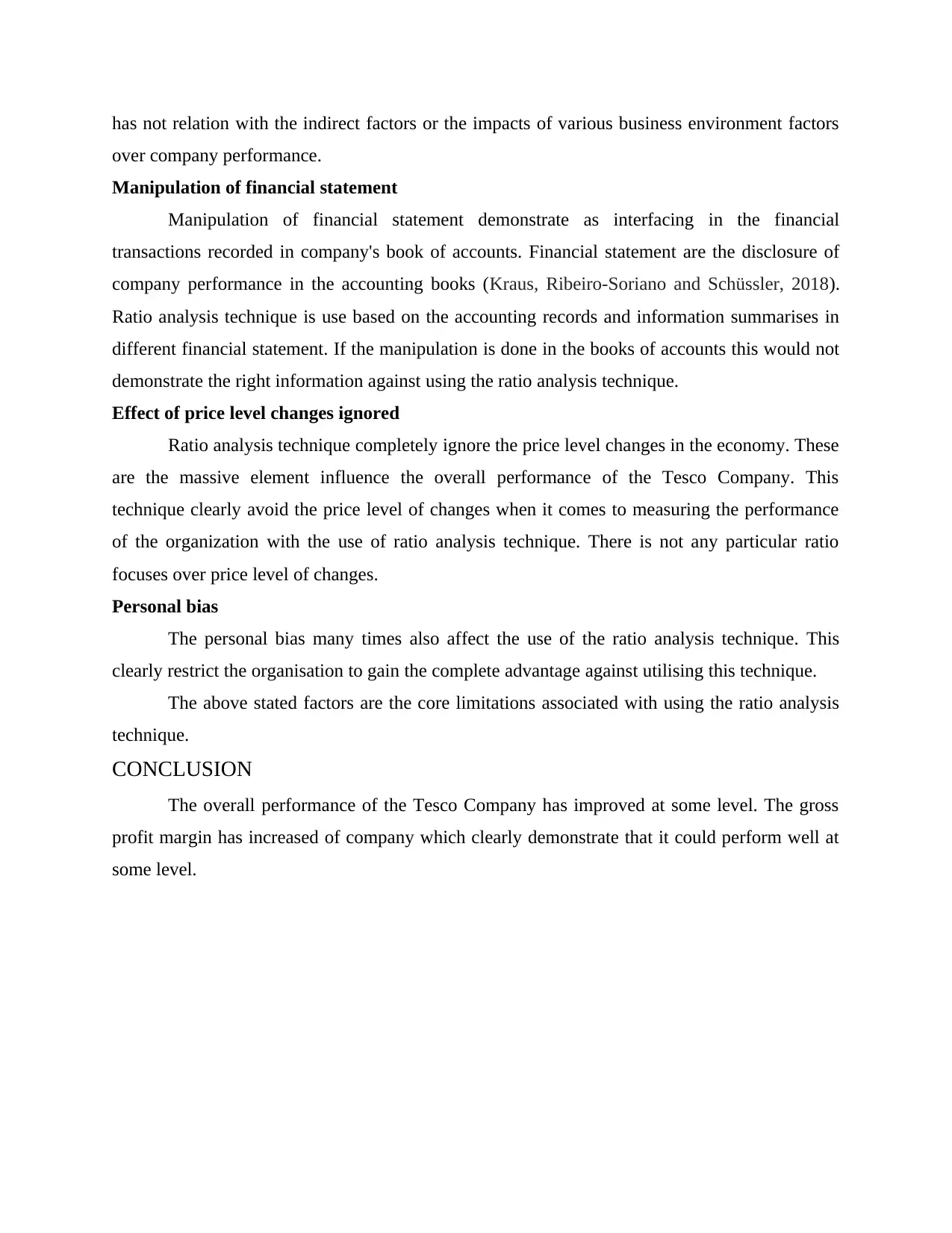
has not relation with the indirect factors or the impacts of various business environment factors
over company performance.
Manipulation of financial statement
Manipulation of financial statement demonstrate as interfacing in the financial
transactions recorded in company's book of accounts. Financial statement are the disclosure of
company performance in the accounting books (Kraus, Ribeiro-Soriano and Schüssler, 2018).
Ratio analysis technique is use based on the accounting records and information summarises in
different financial statement. If the manipulation is done in the books of accounts this would not
demonstrate the right information against using the ratio analysis technique.
Effect of price level changes ignored
Ratio analysis technique completely ignore the price level changes in the economy. These
are the massive element influence the overall performance of the Tesco Company. This
technique clearly avoid the price level of changes when it comes to measuring the performance
of the organization with the use of ratio analysis technique. There is not any particular ratio
focuses over price level of changes.
Personal bias
The personal bias many times also affect the use of the ratio analysis technique. This
clearly restrict the organisation to gain the complete advantage against utilising this technique.
The above stated factors are the core limitations associated with using the ratio analysis
technique.
CONCLUSION
The overall performance of the Tesco Company has improved at some level. The gross
profit margin has increased of company which clearly demonstrate that it could perform well at
some level.
over company performance.
Manipulation of financial statement
Manipulation of financial statement demonstrate as interfacing in the financial
transactions recorded in company's book of accounts. Financial statement are the disclosure of
company performance in the accounting books (Kraus, Ribeiro-Soriano and Schüssler, 2018).
Ratio analysis technique is use based on the accounting records and information summarises in
different financial statement. If the manipulation is done in the books of accounts this would not
demonstrate the right information against using the ratio analysis technique.
Effect of price level changes ignored
Ratio analysis technique completely ignore the price level changes in the economy. These
are the massive element influence the overall performance of the Tesco Company. This
technique clearly avoid the price level of changes when it comes to measuring the performance
of the organization with the use of ratio analysis technique. There is not any particular ratio
focuses over price level of changes.
Personal bias
The personal bias many times also affect the use of the ratio analysis technique. This
clearly restrict the organisation to gain the complete advantage against utilising this technique.
The above stated factors are the core limitations associated with using the ratio analysis
technique.
CONCLUSION
The overall performance of the Tesco Company has improved at some level. The gross
profit margin has increased of company which clearly demonstrate that it could perform well at
some level.
⊘ This is a preview!⊘
Do you want full access?
Subscribe today to unlock all pages.

Trusted by 1+ million students worldwide
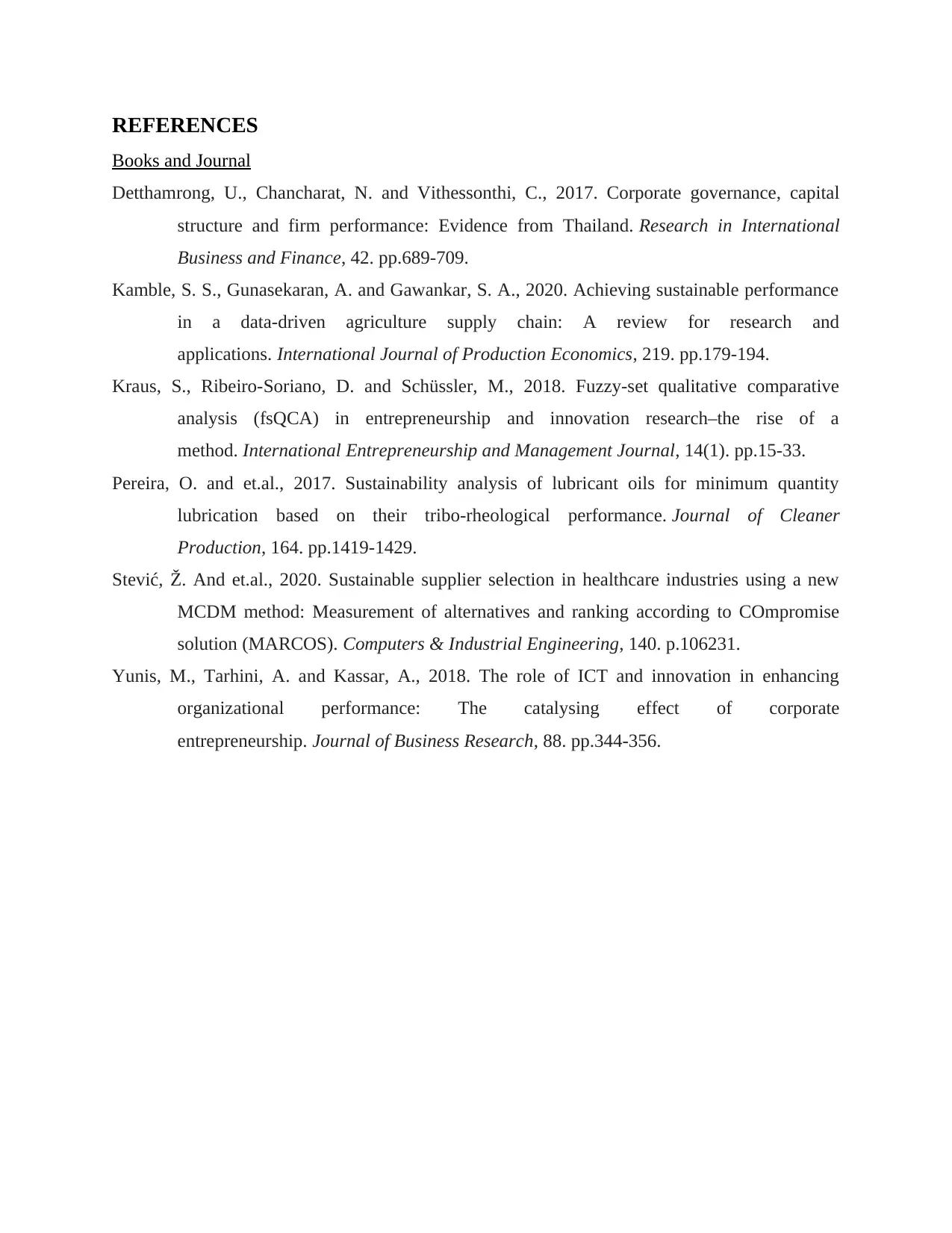
REFERENCES
Books and Journal
Detthamrong, U., Chancharat, N. and Vithessonthi, C., 2017. Corporate governance, capital
structure and firm performance: Evidence from Thailand. Research in International
Business and Finance, 42. pp.689-709.
Kamble, S. S., Gunasekaran, A. and Gawankar, S. A., 2020. Achieving sustainable performance
in a data-driven agriculture supply chain: A review for research and
applications. International Journal of Production Economics, 219. pp.179-194.
Kraus, S., Ribeiro-Soriano, D. and Schüssler, M., 2018. Fuzzy-set qualitative comparative
analysis (fsQCA) in entrepreneurship and innovation research–the rise of a
method. International Entrepreneurship and Management Journal, 14(1). pp.15-33.
Pereira, O. and et.al., 2017. Sustainability analysis of lubricant oils for minimum quantity
lubrication based on their tribo-rheological performance. Journal of Cleaner
Production, 164. pp.1419-1429.
Stević, Ž. And et.al., 2020. Sustainable supplier selection in healthcare industries using a new
MCDM method: Measurement of alternatives and ranking according to COmpromise
solution (MARCOS). Computers & Industrial Engineering, 140. p.106231.
Yunis, M., Tarhini, A. and Kassar, A., 2018. The role of ICT and innovation in enhancing
organizational performance: The catalysing effect of corporate
entrepreneurship. Journal of Business Research, 88. pp.344-356.
Books and Journal
Detthamrong, U., Chancharat, N. and Vithessonthi, C., 2017. Corporate governance, capital
structure and firm performance: Evidence from Thailand. Research in International
Business and Finance, 42. pp.689-709.
Kamble, S. S., Gunasekaran, A. and Gawankar, S. A., 2020. Achieving sustainable performance
in a data-driven agriculture supply chain: A review for research and
applications. International Journal of Production Economics, 219. pp.179-194.
Kraus, S., Ribeiro-Soriano, D. and Schüssler, M., 2018. Fuzzy-set qualitative comparative
analysis (fsQCA) in entrepreneurship and innovation research–the rise of a
method. International Entrepreneurship and Management Journal, 14(1). pp.15-33.
Pereira, O. and et.al., 2017. Sustainability analysis of lubricant oils for minimum quantity
lubrication based on their tribo-rheological performance. Journal of Cleaner
Production, 164. pp.1419-1429.
Stević, Ž. And et.al., 2020. Sustainable supplier selection in healthcare industries using a new
MCDM method: Measurement of alternatives and ranking according to COmpromise
solution (MARCOS). Computers & Industrial Engineering, 140. p.106231.
Yunis, M., Tarhini, A. and Kassar, A., 2018. The role of ICT and innovation in enhancing
organizational performance: The catalysing effect of corporate
entrepreneurship. Journal of Business Research, 88. pp.344-356.
1 out of 7
Related Documents
Your All-in-One AI-Powered Toolkit for Academic Success.
+13062052269
info@desklib.com
Available 24*7 on WhatsApp / Email
![[object Object]](/_next/static/media/star-bottom.7253800d.svg)
Unlock your academic potential
Copyright © 2020–2025 A2Z Services. All Rights Reserved. Developed and managed by ZUCOL.





